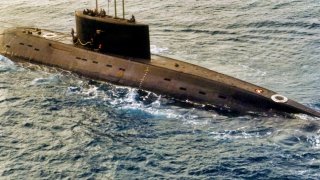China Lost a Brand New Nuclear Attack Submarine: We Want to Know Why
China’s ambitions to challenge U.S. naval supremacy suffered a major setback when its newest nuclear-powered attack submarine sank during construction earlier this year. U.S. defense officials revealed the incident, which Beijing attempted to cover up.
What You Need to Know: China’s ambitions to challenge U.S. naval supremacy suffered a major setback when its newest nuclear-powered attack submarine sank during construction earlier this year. U.S. defense officials revealed the incident, which Beijing attempted to cover up.
-The lead vessel in a new class of submarines, the sinking highlights the challenges China faces in achieving military parity with the United States. While China’s navy is rapidly modernizing, this incident underscores its industrial and operational shortcomings.
-As Beijing pushes to become a superpower, incidents like this show it still has a long way to go in competing with U.S. naval capabilities.
-The Chinese Navy suffered a significant setback in achieving parity with the United States Navy.
Chinese Navy Faces Setback as New Nuclear Submarine Sinks During Construction
On Friday, U.S. defense officials revealed that Beijing’s newest nuclear-powered attack submarine sunk in its shipyard while under construction in the spring.
The Chinese military tried to cover up the embarrassing incident, but now U.S. defense officials revealed the truth.
Submarine Down for China: An Embarrassing Incident
The Pentagon has confirmed that China’s newest nuclear-powered attack submarine sunk last spring while undergoing contruction in a shipyard. Then, Beijing tried to hide the fact that the submarine had sunk. The sub in question is the lead ship in a new class of submarines.
“It’s not surprising that the PLA Navy would try to conceal the fact that their new first-in-class nuclear-powered attack submarine sank pierside,” said the senior U.S. defense official.
“We are not familiar with the situation you mentioned and currently have no information to provide,” a spokesperson from the Chinese embassy in Washington, DC, told CNN.
The Wall Street Journal was the first to report the sinking of the newest Chinese submarine, while Tom Shugart, a former submariner and current associate at the Center for a New American Security think tank was the first to spot the unusual activity through satellite imagery.
“It is unclear if this shipyard is certified to handle nuclear materials. As such, we do not know if the submarine reactor was fueled at the time of the incident or if it is going to be relocated to a known nuclear-certified facility for its initial fueling, such as Huludao Shipyard, which has built all previous PLA Navy nuclear submarine classes,” according to a military official.
The U.S. Navy currently has 71 submarines, each powered by nuclear energy. In total, the Navy has 53 attack subs, designed to find and sink enemy ship, 14 ballistic missile subs, which carry nuclear warheads and ensure America’s maritime nuclear deterrent, and 4 guided missile subs, which can fire hundreds of cruise missiles on land targets.
In comparison, the Chinese Navy has approximately 60 submarines, 48 of which are powered by diesel. Beijing is rapidly modernizing its military forces but is running into roadblocks.
Superpower Aspirations and Challenges
The incident showcases the extreme challenges of designing, building, and maintaining an advanced military force. There is a reason why the U.S. is the world’s superpower and has the military and industrial complex to back its claim. Beijing also seeks to become a superpower and challenge the U.S. But evidently, it is some years before it can achieve that.
Much of China’s strategy hinges on stealing other countries' technology and intellectual property and replicating it. The U.S. Intelligence Community assesses that Beijing is stealing as much as $600 billion worth of intellectual property from the U.S. every year. After stealing this intellectual property, Beijing gets to work on replicating it. But you can’t replicate human industry or operational experience. And China lacks both, especially the latter.
Make no mistake, China is looking to challenge the U.S. But its military still needs to work before it can compete with America and its allies.
About the Author:
Stavros Atlamazoglou is a seasoned defense journalist specializing in special operations and a Hellenic Army veteran (national service with the 575th Marine Battalion and Army HQ). He holds a BA from the Johns Hopkins University and an MA from the Johns Hopkins’ School of Advanced International Studies (SAIS). His work has been featured in Business Insider, Sandboxx, and SOFREP.
Image Credit: Creative Commons.


